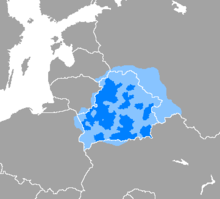Belarusian language
| Belarusian | |
|---|---|
| беларуская мова biełaruskaja mova |
|
| Native to | Belarus, in 14 other countries |
| Ethnicity | 8 million Belarusians in Belarus (2009 census) |
|
Native speakers
|
3.2 million (2.2 million in Belarus) (ca. 2009 census) |
|
Indo-European
|
|
|
Early forms
|
Old East Slavic
|
|
Cyrillic (Belarusian alphabet) Belarusian Braille Belarusian Latin alphabet |
|
| Official status | |
|
Official language in
|
|
|
Recognised minority
language in |
|
| Regulated by | National Academy of Sciences of Belarus |
| Language codes | |
| ISO 639-1 | be |
| ISO 639-2 | |
| ISO 639-3 | |
| Glottolog | bela1254 |
| Linguasphere | 53-AAA-eb < 53-AAA-e |

Belarusian-speaking world
Legend: Dark blue - territory, where Belarusian language is used chiefly |
|
Belarusian (/bɛləˈruːsiən/;беларуская мова bielaruskaja mova [bʲelaˈruskaja ˈmova]) is an official language of Belarus, along with Russian, and is spoken abroad, chiefly in Russia, Ukraine, and Poland. Before Belarus gained independence from the Soviet Union in 1991, the language was known in English as Byelorussian or Belorussian, transliterating the Russian name, белорусский язык, or alternatively as White Ruthenian (/ruːˈθiːniən/) or White Russian (with the meaning Rus' but not Russia). Following independence, it also became known as Belarusian.
Belarusian is one of the East Slavic languages and shares many grammatical and lexical features with other members of the group. To some extent, Russian, Ukrainian, and Belarusian are mutually intelligible. Its predecessor stage is known as Old Belarusian (14th to 17th centuries), in turn descended from Old East Slavic (10th to 13th centuries).
...
Wikipedia
